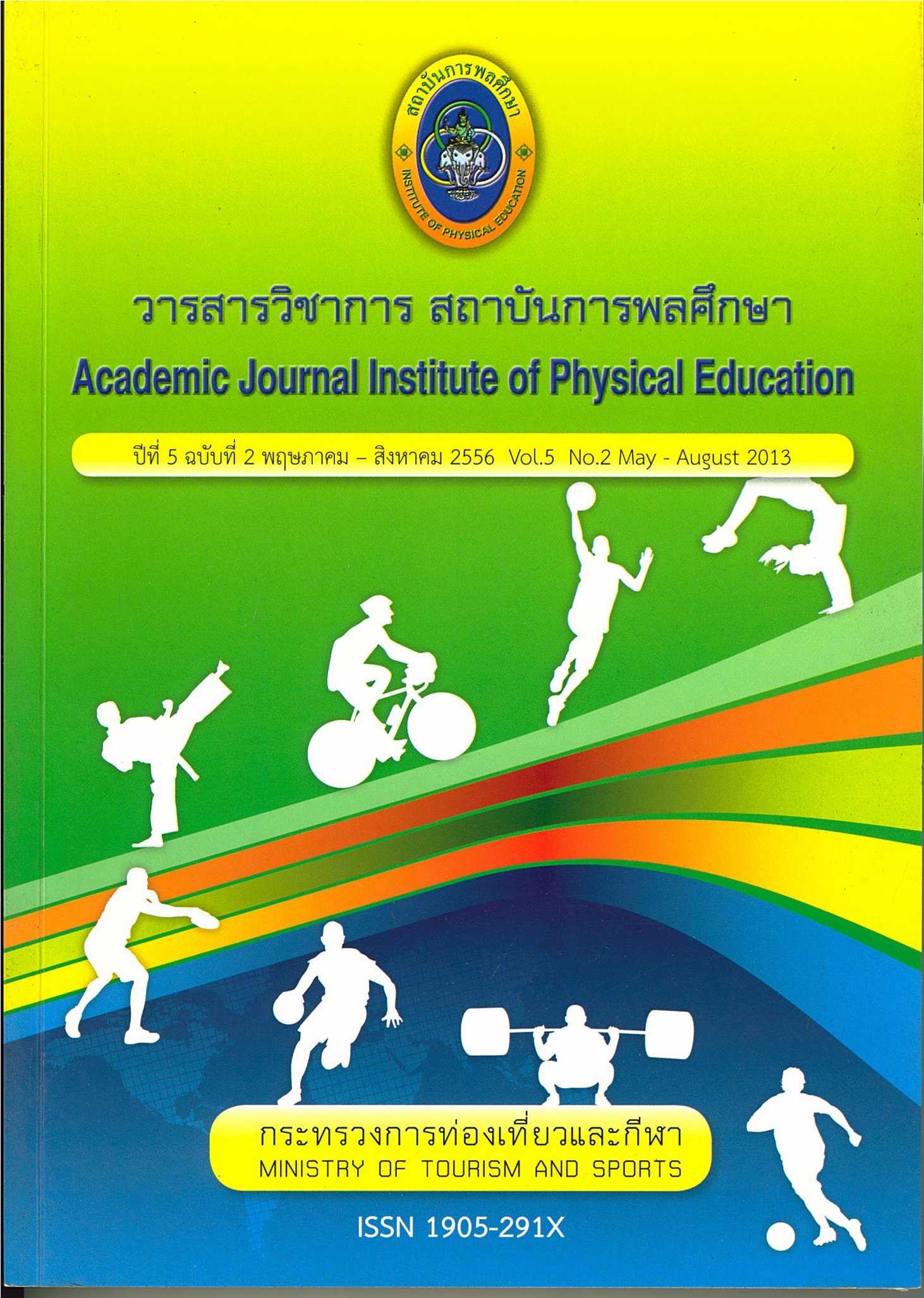THE DEVELOPMENT OF STUDENT'S PROFESSIONAL ETHICS IN THE INSTITUTE OF PHYSICAL EDUCATION BY INTEGRATIVE RESEARCH
Main Article Content
Abstract
The purposes of this research were to: 1) investigate the level of physical education student's professional ethics in the Institute of Physical Education; 2) analyze the factors of physical education student's professional ethics; 3) construct the norms of each year physical education student's professional ethics; 4) create the integrative research process for developing physical education student's professional ethics; 5) compare the results of development in physical education student's professional ethics with the constructed norms; and 6) compare the results of development in physical education student's professional ethics by using three integrative research methods comprising 1) Appreciation Influence Control, 2) Appreciation Influence Control and Participatory
Action Research, and 3) Appreciation Influence Control, Participatory Action Research and Mentoring. The samples for quantitative research consisted of 640 physical education students and 326 teachers in Institute of Physical Education by two stage sampling. Six point Likert's scale was used to collect data for factor analysis. The samples for integrative research process comprised of the first and second year Suphanburi physical education students. The samples of 24 students were divided into three groups: one control group and two experimental groups. One mentor and three teachers were participate in the experiment. The data collection was conducted by interview, group discussion, literature review and participation survey. Qualitative data was analyzed by content analysis method. The quantitative data was collected by the constructed scale and analyzed by one way analysis of variance.
The findings revealed that:
- As a whole and divided by academic years, the level of physical education students' professional ethics in the Institute of Physical Education was found in a moderate level, compared with the constructed norms. The normalized T-score of the first year students was 48 (=238.51, = 22.93), the second year students was 49 (=237.58, = 23.60), the third year students was 47 (=239.01, = 23.76), the fourth year students was 47 (=248.45, = 25.13), and overall student was 46 (=240.89, = 23.44).
- The constructed norms of physical education students' professional ethics in Institute of Physical Education were as the following: normalized T-score range below 35 was in an inferior level; 35-44 was a low level; 45-54 was a moderate level; 55-64 was a high level; and above 64 was a superior level. The results compared with the constructed norms indicated that the normalized T-score range of the first year students was between 23-77, the second year students was between 23-73, the third year students was between 23-77, the forth year students was between 23-75, and the overall range was between 17-77.
- Eight factors of physical education students' professional ethics in Instituto of Physical Education included 1) self-discipline, 2) role model, 3) sportsmanship, 4) generosity, 5) sympathy, 6) professional faith, 7) endurance and 8) honesty.
- Model of development in physical education students' professional ethics contained five major stages: 1) setting goals for development, 2) setting procedure and building up participation, 3) constructing development plan, 4) conducting the implementation and the evaluation, and 5) reviewing and taking action for new goal setting.
- Compared with the constructed norms, the results of development in physical education students' professional ethics were found that the first experimental group had the normalized T-score at 58 (=267.38, = 3.89) which was a high level; the second experimental group had the normalized T-score at 56 (=263.63, = 5.40) which was a high level; and the control group had the normalized T-score at 53 (=256.13, = 6.51) which was a moderate level.
- Significant difference in the results of the development in physical education students' professional ethics was found between the control group and the two experimental groups at the level of .05, whereas no significant difference was found between the first experiment group and the second experiment group.
Article Details
The published article is a copyright of the Academic Journal of Thailand National Sports University. The passage appeared in each article in this academic journal is a perspective of each author which is not related to the journal. Each author is required to be responsible for all components of his/her own article. If there are any mistakes, each author must be responsible for those mistakes on his/her own.
References
เกรียงศักดิ์ เจริญวงศ์ศักดิ์ (2550). สรุปคําบรรยายในการสัมมนาทางวิชาการ เรื่อง การวิจัยกับการส่งเสริมและพัฒนาคุณธรรมจริยธรรมเยาวชนไทย. วันที่ 6 กันยายน 2550 ณ ห้องประชุมชั้น 8 อาคารจันทรากาญจนาภิเษก, มหาวิทยาลัยราชภัฏจันทรเกษม.
โชคชัย ปัญญาคํา. (2550). ปัจจัยที่ส่งผลต่อคุณลักษณะด้านจริยธรรมของนักศึกษาสถาบันการพลศึกษา วิทยาเขตเชียงใหม่, ศึกษาศาสตรมหาบัณฑิต (วิจัยและสถิติการศึกษา) มหาวิทยาลัยเชียงใหม่,
รัตนา อินธิเสน. (2550) คุณลักษณะที่เป็นจริงและที่พึงประสงค์ของครูพลศึกษาในทัศนะของนักศึกษาสถาบันสถาบันการพลศึกษา ในเขตภาคตะวันออกเฉียงเหนือ ปีการศึกษา 2549. วิทยานิพนธ์การศึกษามหาบัณฑิต สาขาพลศึกษา มหาวิทยาลัยศรีนครินทร วิโรฒ.
ล้วน สายยศ และอังคณา สายยศ. (2543). การวัดด้านจิตพิสัย กรุงเทพฯ : สุวีริยาสาส์น.
สมโภชน์ อเนกสุข. (2553). วิธีการทางสถิติสําหรับการวิจัย = Statistical methods for research พิมพ์ครั้งที่ 3. ภาควิชาวิจัยและวัดผลการศึกษา คณะศึกษาศาสตร์ มหาวิทยาลัยบูรพา.
อนุชา กิติชัยชาญ และคณะ. (2549). คุณลักษณะของบัณฑิตสถาบันการพลศึกษาตามความต้องการของสถานประกอบการและผู้ผลิตบัณฑิต. สถาบันการพลศึกษาวิทยาเขตเชียงใหม่.
Kemmis, S. & Mc Taggart, R. (2000). Participatory Action Research. In N.K. Denzin and Y.S.Lincoln (Eds.), Handbook of Qualitative Research. (2nd ed., pp.567-605). Thousand Oaks, CA: Sage.
Hair, J. F., Black, W. C., Babin, B. J. and Anderson, R. E. and Tatham, R. L. (2006). Multivariate Data Analysis. 6th ed. Upper Saddle River, New Jersey: Prentice Hall, inc.

